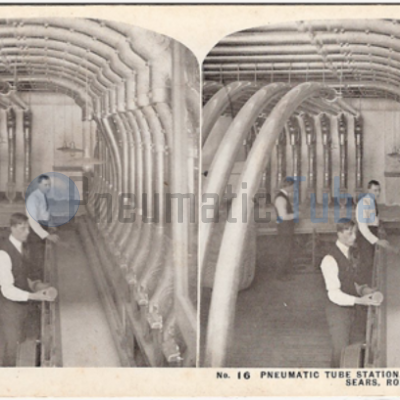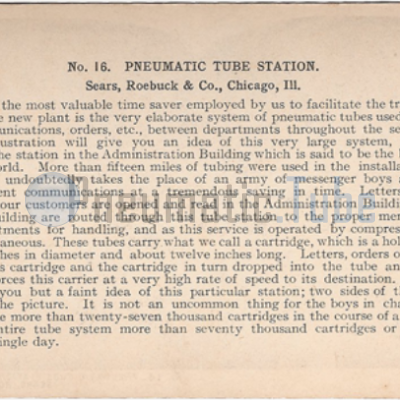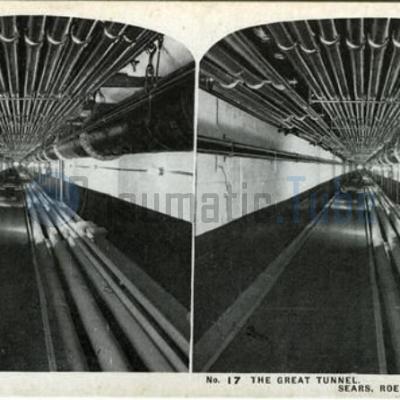Pneumatic Tube Station Sears, Roebuck & Co., Chicago Ill.
Photos on stereoscopic photo cards made at the Sears, Roebuck, & Co headquarters in Chicago around 1906.
Card #16 - Pneumatic Tube Station
Probably the most valuable time saver employed by us to facilitate the transaction of business in the new plant is the very elaborate system of pneumatic tubes used for sending written communications, orders, etc., between departments throughout the several buildings. The illustration will give you an idea of this very large system, this picture representing the station in the Administration Building which is said to be the largest of its kind in the world. More than fifteen miles of tubing were used in the installation of this system and it undoubtly takes the place of an army of messenger boys and handles inter-department communications at a tremendous saving in time. Letters and orders received from our customers are opened and read in the Administration Building and from this central building are routed through this tube station to the proper merchandise or clerical departments for handling, and as this service is operated by compressed air it is almost instantaneous. These tubes carry what we call a cartridge, which is a hollow cylinder about four inches in diameter and about twelf inches long. Letters, orders or papers are inserted in this cartridge and the cartridge in turn dropped into the tube and the great air pressure forces this carrier at a very high rate of speed to its destination. This illustration gives you a faint idea of this particular station; two sides of the room not appearing in the picture. It is not an uncommon thing for the boys in charge of this room to handle more than twenty-seven thousand cartridges in the course of a day's work, and in the entire tube system more than seventy thousand cartridges or carriers are handled in a single day.
Card #17 - The Great Tunnel
Beginning at the power plant is a very complete system of underground tunnels, constructed of concrete and extending under all the buildings of the general plant, connecting the various buildings with each other. It is possible by means of the tunnels to reach every building in our forty-acre plant, and the very large expense entailed by the construction of this system was assumed in order to facilitate the prompt movement of merchandise and to afford every possible advantage in the expeditious handling of the vast quantities of mail received and forwarded to the several departments daily. These tunnels are almost a mile in length; they carry the electric conduits, heating pipes, water mains, steam pipes, etc. which are required in the various buildings. Probably the greatest advantage we find these tunnels give us lies in the fact that any one section or building might be destroyed by fire without interfering with our private fire protection system, the two telephone systems and the wires carrying electric current for lightning and power. It is a very simple matter to cut off the water, the heat, the light or the power from any section or building at the point of junction in the tunnel. In a plant so large it is necessary to adopt every means possible to protect the institution from total destruction, and to insure the transaction of business from day to day without interruption though disaster should overtake a portion of the plant. In addition to using the tunnels for the several conduits necessary to carry electric current, heat and water, we also utilize them in conveying the great quantities of refuse matter, broken packing cases, sweepings, discarded records, correspondence, etc. to the furnace room in the power plant where this refuse matter is converted into heat, light and power. All the tunnels are large enough for the average individual to pass through them walking erect. It may interest you to know that these tunnels and their connections carry 100 miles of pipe for heating purposes, 4,400 miles of copper wire for carrying electric current, and then miles of steel metal pipe for carrying heated air in the winter time and filtered cool air in the summer time.
All 50 - not pneumatic tube related - cards can be seen here: sears.sevenels.net
 Pneumatic Tube, Rohrpost, Buizenpost
Pneumatic Tube, Rohrpost, Buizenpost
Pneumatic Tube Station Sears, Roebuck & Co., Chicago Ill.
Published: 29-01-2010
Last updated: 12-08-2018
Show related articles:
Pneumatic Tube Calendar
24 October 1864 (160 years ago)
Commissioning Pneumatic Tube Mail Hamburg, Germany
31 October 1874 (150 years ago)
Pneumatic Tube Mail railway in London, Great Britain out of business
1 October 1879 (146 years ago)
The Mix & Genest company was founded by the businessman Wilhelm Mix and the engineer Werner Genest in Berlin-Schöneberg
7 October 1897 (128 years ago)
Commissioning Pneumatic Tube Mail New York USA


